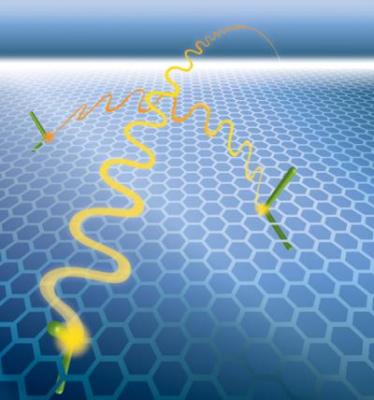Researchers at the Lawrence Berkeley National Laboratory (Berkeley Lab) of U.S. Department of Energy have performed research to study how undoped graphene functions close to the "Dirac point”,which is present only in graphene. David Siegel, the key author of a paper reporting the team's research findings in the Proceedings of the National Academy of Sciences (PNAS) stated that graphene is not an insulator, semiconductor or a metal but a unique kind of semimetal with interesting electronic properties.
 Electron-electron interactions on graphene's honeycomb lattice
Electron-electron interactions on graphene's honeycomb lattice
Using the ALS beamline 12.0.1, Siegel and his co-workers inspected a sample of graphene prepared with angle-resolved photoemission spectroscopy (ARPES) to determine how graphene which does not have any charge carriers behaves close to the “Dirac point”. The “Dirac point is a special feature of the band structure of graphene.
Graphene has no energy gap between the vacant conduction band and the electron-filled valence band. These bands are symbolized by Dirac cones whose points come in contact, and intersect linearly at the Dirac point. Graphene exhibits a set of unique properties when the conduction band is vacant and the valence band of graphene is filled.
An ARPES experiment measures a portion in between the cones by plotting directly the angle of electrons and kinetic energy obtained from the graphene sample when the ALS emits an X-ray on the sample to cause excitation. When the emitted electrons come in contact with the detector screen, a spectrum is formed and slowly develops into a cone.
Electrons interact in a unique way in undoped graphene when compared to a metal. The sides of the cone form an inward curvature, showing that electronic interactions can take place even at distances up to 790Å apart and contribute to higher electron velocities. These are extraordinary properties arising due to a common phenomenon known as "renormalization."
So Siegel and his coworkers conducted studies on “quasi-freestanding” graphene, with a silicon carbide substrate. At high temperatures, the silicon is pushed out of the silicon carbide and carbon collects as a thick layer of graphite on the surface. But successive graphene layers present in the thick sample of graphite are rotated in such a way that an each layer acts like an individual isolated layer in the stack. He added that undoped graphene is very much different from a normal Fermi liquid, and their results are in-line with theoretical computations.
Siegel stated that unscreened, long-range interactions take place in graphene, which alters the behavior of graphene in a basic way.